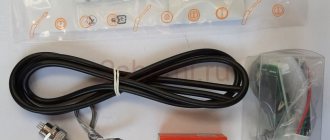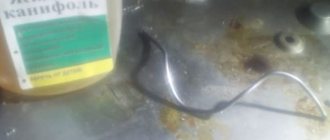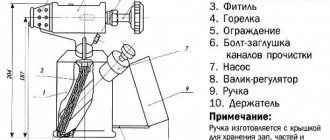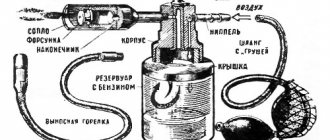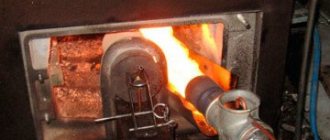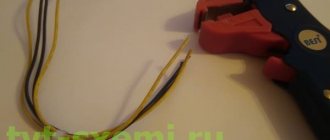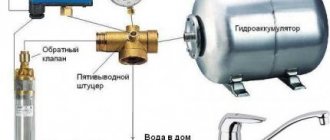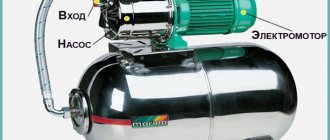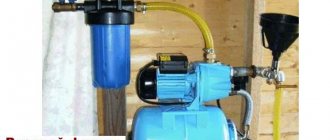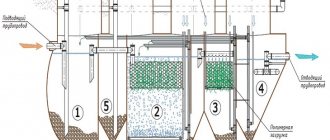When working with a soldering station or a simple soldering iron, such an element of this equipment as a replaceable tip (tip) greatly affects the quality of soldering. It transfers the bulk of the heat from the heater to the solder and ensures a high-quality and reliable connection of the soldered radio components with the conductive paths. Therefore, both an experienced master and a novice radio amateur need to know what a tip is, what types there are, how to choose it correctly, and, if necessary, make it with your own hands from scrap materials.
Standard tip for soldering station
What are stings made of?
Regular copper tip with non-burning coating
The most common and simple modern models of tips are made from the most heat-conducting and inexpensive metal - copper, they have the following structure:
- Base (copper rod), which serves to accumulate and transfer heat from the heating element to the tip of the tip;
- A protective layer of galvanic iron that prevents copper from burning out when heated;
- The outer non-burning chrome layer protects the underlying layer of galvanic iron from damage.
Induction soldering station
The very tip of the tip, which is in direct contact with the solder, is coated with a special alloy, which is very easy to tinning and does not require additional cleaning after/before starting soldering work.
Important! A modern chrome-plated tip, unlike its old Soviet counterparts, cannot be cleaned (tinned) using various abrasive tools (knife) - this can lead to damage to the protective layers that cover the base and further burnout of the copper.
A radio amateur's soldering iron - what should it be like?
The soldering iron is used to convert electrical energy into heat. Using heat transfer, a soldering iron is capable of melting solder and flux, in a word, soldering radio components.
A classic soldering iron looks like a metal rod with a tip and a wooden handle. At the end of the soldering iron there is a copper tip, which is the main heat transfer element.
Types of tips
Micro soldering iron for soldering microcircuits
Depending on the material of manufacture, the presence or absence of coating, the shape of the working part, tips are divided into many types.
Material of manufacture
Depending on what material the base of the tip is made of and whether it has a special non-burning coating, tips for soldering equipment are of the following types:
- Simple copper without coating - made of copper, they do not have a protective coating, as a result of which they burn very quickly and fail. Recently, only the cheapest and simplest network soldering irons have been equipped with such tips.
- Copper tips with a non-burning coating are the most common and inexpensive tips, in which the copper base is covered with two protective layers that prevent the copper from burning out and significantly increase the service life of the tip.
- Ceramic - rare tips made from special ceramics with high thermal conductivity. They were not widely used due to their fragility and high price.
- Composite - made of 2-3 metals (copper, nickel, iron), such working parts of soldering equipment are even less common than ceramic ones, as they have an even higher cost.
Of the 4 types of tips described, the most convenient and inexpensive are copper models with a non-burning coating.
Working part shape
Types of tips according to the shape of the working part
Also, tips for soldering equipment are divided into 5 types according to the shape of the working part of the tip:
- “Needle” - a tip with a thin tip is used for soldering very small radio components.
- “Spatula” is a chisel-shaped, slightly beveled tip with a large area of contact with the working surface and slow cooling. Used for soldering and desoldering large radio components.
- “Drop” - used for carrying a small amount of solder and soldering small and medium-sized radio components;
- “Curved” - convenient when carrying out soldering work in limited space, removing excess solder, dismantling burnt radio components;
- “Cone” is a standard tip, due to its large thickness and shape, combining the advantages of the types described above.
The most convenient and common among these types of tips is cone-shaped - it is used for most soldering work, has a relatively low cost, is durable and reliable.
Tip selection
How to choose a soldering station: equipment classification and features
The main criteria that are taken into account when answering the question of which tip is best for a particular soldering iron are its purpose, the presence of a non-burning coating, and the base material.
Purpose
Taking this criterion into account, tips for soldering equipment are selected as follows:
- For household one-time operations performed with conventional network soldering irons, choose simple copper tips without a protective non-burning layer;
- For a beginning radio amateur who, as a rule, uses a soldering iron with a ceramic heater, the most convenient and affordable will be copper models with a non-burning coating;
- The most reliable and durable composite models are suitable for craftsmen engaged in professional repair of household equipment.
Using expensive tips for one-time work is impractical, and most importantly, unprofitable.
Presence of non-burning coating
Despite the presence on the market of a large number of models of tips without this protective layer, it is still recommended to give preference to tips that have this coating - they are more convenient, do not require cleaning from tinning before starting soldering work, and have a wide variety of shapes of the working part.
Base material
Among the wide variety of base materials, the most reliable, with high thermal conductivity and durability, is copper. Ceramic-based tips, with the same heating time as copper analogues, have one significant drawback - fragility.
Tips series 900M - T
900M-T series models
Among this series of tips for soldering equipment, the following models are the most popular:
- 900M-T-K is the most common and “running tip” in the form of a small blade. This tip is used for most soldering jobs;
- 900M-T-3S and T-4S are models with a working part in the form of a truncated cylinder. Used for tinning conductive paths of printed circuit boards and small copper pads.
- 900M-T-1.6/2.4/3.2 D – models with a blade-shaped working part. They are used for soldering small microcircuits, diodes, etc.
- 900M-T-IS is a model with a thin and curved tip. Used when working with miniature radio components, soldering in hard-to-reach places on printed circuit boards.
Despite the fact that most of the models in this series are copies of Japanese tips, they are of fairly high quality and durability. The only drawback of such tips is their lower heat transfer compared to branded models.
Tip cleaner
Tip cleaner
To remove solder remaining on the tip at the end of soldering work, use such a simple device as a tip cleaner. The simplest of cleaners is a ball of brass or steel shavings, which, when touched with the tip, removes excess solder and carbon deposits.
Temperature stabilizer
To ensure that the temperature of the tip tip is optimal during the soldering process, temperature stabilizers are used in soldering stations and modern soldering irons.
The most common built-in thermal stabilizer of a simple soldering iron includes the following components:
- A sensor built into the tip and sends signals to the control board about its heating temperature;
- An analog or digital regulator installed in the handle of a soldering iron, with the help of which the temperature value to which it is necessary for the tip to warm up is fixed.
If one of these components fails, the tip will either not heat up or overheat. In both cases, high-quality soldering will not work - the soldering iron will either not be able to melt the solder, or it will overheat and damage the radio component, which is sensitive to high temperatures.
Types of soldering iron tips
The main difference is the material of manufacture. It determines the performance characteristics of the tip. If initially only copper products dominated, today the choice is becoming wider.
Copper
Craftsmen believe that the best tip for a soldering iron is copper. For a long time, manufacturers produced this particular option, as it is durable. The material conducts heat, which is also an important quality. Copper is cheap compared to other tip materials. Often, fixed tips on budget tools are made from it. Copper is a relatively easy metal to process, from which you can independently make a replacement for a used tool.
Copper soldering iron tips
Fireproof
Unburnt tips are vulnerable to mechanical processing. This is a delicate option, as it must be handled with care, otherwise there is a risk of spoiling it. Under no circumstances should sandpaper or files be used, otherwise the protective layer will peel off and the entire tip will lose its advantage. The protective layer prevents the material from burning. For processing, you only need to use a special sponge soaked in the dissolving composition. The size of the soldering iron tip does not matter, since the top layer remains thin.
Unburnt tip
Ceramic
A soldering iron tip made of ceramic material is durable, just like the metal version. The heat capacity and thermal conductivity here are much inferior to copper. The product is not subject to corrosion and is more durable. You don't have to worry about constantly cleaning the tip. Thin ceramic tips are excellent for working with radio components.
Ceramic soldering tip
Composite
There are many options as to which soldering iron tip is best to use. Composite ones allow you to combine several properties of different materials, which helps to achieve truly unique properties. Composite models combine two types of materials. For example, steel is placed in the core to achieve strength. Then the length of the soldering iron tip can be higher. The copper becomes the heat-conducting material located between the end and the heating element. Nickel is applied as a top coating to protect against corrosion. A silver alloy is placed at the end of the tip used to perform the work and is used for better adhesion to the solder.
Making a thin tip
To make a simple sting, the following materials are needed:
- Copper rod with a diameter of 6 mm;
- A rod made of technical silver with a diameter of 5 mm and a length of 10-15 mm.
The sting manufacturing process consists of the following steps:
- On a lathe, the copper workpiece is turned to a diameter equal to a similar one, which has a ceramic heating element for the soldering iron, into which the tip will be inserted;
- A hole is drilled at the end of the workpiece and an M4 thread is cut;
- In a jewelry workshop they order a 10-centimeter rod made of the cheapest technical silver;
- A piece 20-25 mm long is cut from a silver rod, an M4 thread is cut at its end;
- The threaded silver tip is screwed into the copper base of the homemade sting.
A tip made in this way will heat up quickly; thanks to the presence of silver, solder will “stick” to it well.
